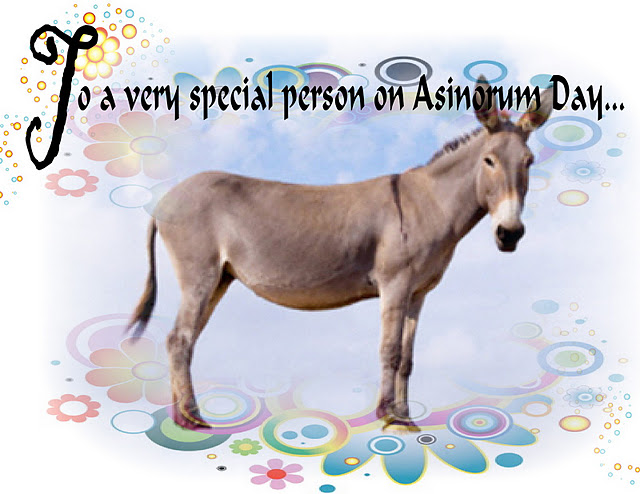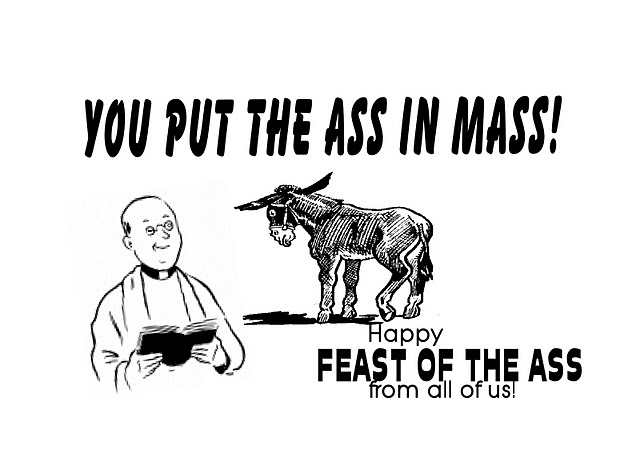Today, 14 January, is the Feast of the Ass, Asses… the Festum Asinorum (in Latin, plural).
No, I am not talking about whom you think I’m talking about.
The feast which became popular in France, could have stemmed from the so-called “feast of fools”. It may tendrils into biblical donkeys, or the integration of the ass into the nativity narrative. It could have been in part inspired by a sermon of pseudo-Augustine.
The day included the tradition of a parading a couple of kids (not goats) on an ass (not a Jesuit) right into the church, next to the pulpit during the sermon. The congregation would respond with loud “hee haws”.
Who said that the Middle Ages were dreary?
In any event, it was celebrated for a long time and then faded out.
Here are possible greeting cards.

One for your parish priests….
Dear Fr. ___

There is a rather long entry about this at Wikipedia. It includes a liturgical note:
At Beauvais the Ass may have continued his minor role of enlivening the long procession of Prophets. On the January 14, however, he discharged an important function in that city’s festivities. On the feast of the Flight into Egypt the most beautiful girl in the town, with a pretty child in her arms, was placed on a richly draped ass, and conducted with religious gravity to St. Stephen’s Church. The Ass (possibly a wooden figure) was stationed at the right of the altar, and the Mass was begun. After the Introit a Latin prose was sung.
The first stanza and its French refrain may serve as a specimen of the nine that follow:
- Orientis partibus
Adventavit Asinus
Pulcher et fortissimus
Sarcinis aptissimus.
Hez, Sire Asnes, car chantez,
Belle bouche rechignez,
Vous aurez du foin assez
Et de l’avoine a plantez.(From the Eastern lands the Ass is come, beautiful and very brave, well fitted to bear burdens. Up! Sir Ass, and sing. Open your pretty mouth. Hay will be yours in plenty, and oats in abundance.)
Mass was continued, and at its end, apparently without awakening the least consciousness of its impropriety, the following direction (in Latin) was observed:
- In fine Missae sacerdos, versus ad populum, vice ‘Ite, Missa est’, ter hinhannabit: populus vero, vice ‘Deo Gratias’, ter respondebit, ‘Hinham, hinham, hinham.’
(At the end of Mass, the priest, having turned to the people, in lieu of saying the ‘Ite missa est’, will bray thrice; the people instead of replying ‘Deo Gratias’ say, ‘Hinham, hinham, hinham.’)
Here’s a treat for the Feast of the Ass.
Judging from the lyrics, this seems to be the festive installation of the “bishop” …who’s seems, appropriately, to be an ass.
Cliche today, perhaps, but still fun.
Have you sent a greeting card to someone?
There is some really fun music out there for this “feast”. ‘La Messe Des Ânes Et Des Buveurs’ Slightly… slightly.. sacrilegious? It’s not as bad as some of the music you hear in parish churches.
Here is a musical tribute by French composer René Clemencic (+2022) La Fête De L´âne – HERE


































A little donkey or Ass information coming from a true ass, that is me.
We have Donkeys here on our little farm.
Two female Donkeys to be precise, Tulipa and Daisy. Donkeys are very emotional and are more like a puppy than a horse or Mule (Which is a cross between a horse and donkey).
Because they are so emotional they get lonely if you do not have 2. They will get so sad, if you only have 1 donkey, that they will die.
Donkeys are protectors of their pasture. They fend of wild dogs and even in our area of Chile, Pumas, which try to eat our sheep. The male Donkey (Properly called a JACK ASS. The female is called a Jenny Ass) are so protective of their pasture that they will kill any new or unknown animal that they find in their realm. Because of this they often will kill new born sheep who they assume are trespassers. So you must be careful with your live stock around the male donkeys during lambing season. Hence we have two females.
They make excellent pullers of carts and we are training ours to pull logs out of our woods. Donkeys are sure footed and do not get stuck easily, so they are great for this type of work where no tractor can access.
Catholic and the Grace of Jesus Christ on Donkeys:
If you notice donkeys have a dark cross over their shoulders and back. True Donkeys that are pure of blood in their breed, will have this cross on their shoulders. It is a mark that Christ left on them for eternity of their breed in remembrance of Christ riding a donkey into Jerusalem on Palm Sunday. Interesting how Christ chose the lowly to be his trusted steed.
Had forgotten about this, thanks for the reminder. For unsolicited useless trivia purposes, I reside in a county that once produced a tremendous number of asses (animals and, likely, some humans). Had a big part in supplying the pack animals for WWI. The latter contributed some to the effort also, I’m sure.
Great post, Father. Thanks!
Pingback: ROME SHOT 913 | Fr. Z's Blog
Interesting. Looks like clown masses aren’t a modern invention!
Here’s the sprightly tune of Orientis Partibus – which is used without the chorus for several hymns: https://youtu.be/qWdWTsZ7lO8
in a previous job i worked for a hospital whose legal name was “[town] community hospital association”. well of course that was too long to fit on official correspondence from regulatory agencies, so i received mail directed to “[town] community hospital ass” and thus referred to myself as the official hospital ass.